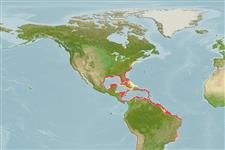>
Carangiformes (Jacks) >
Carangidae (Jacks and pompanos) > Trachinotinae
Etymology: Trachinotus: Greek, trachys, -eia, -ys = rough + Greek,noton = back (Ref. 45335).
More on author: Linnaeus.
Environment: milieu / climate zone / depth range / distribution range
Ecologie
marien; brak water rifbewoner; diepte 0 - 36 m (Ref. 3277), usually 0 - 30 m (Ref. 55175). Subtropical; 42°N - 25°S, 100°W - 30°W (Ref. 55175)
Western Atlantic: Massachusetts, USA to southeastern Brazil, including Bahamas and many of the West Indies (Ref. 7251). Reports from Africa are based on misidentifications, mostly referring to T. teraia (Ref. 81654).
Lengte bij maturiteit / Grootte / Gewicht / Leeftijd
Maturity: Lm 54.7, range 48 - ? cm
Max length : 122 cm FL mannelijk / geslacht onbekend; (Ref. 40637); common length : 94.0 cm FL mannelijk / geslacht onbekend; (Ref. 3277); max. gepubliceerd gewicht: 36.0 kg (Ref. 5217); max. gerapporteerde leeftijd: 23 Jaren (Ref. 42149)
Dorsale stekels (totaal) : 6 - 7; Dorsale zachte stralen (totaal) : 18 - 21; Anale stekels: 2 - 3; Anale zachte stralen: 16 - 18. Dorsal and anal fins have very long, dark anterior lobes (Ref. 26938). No scutes; a broad patch of orange-yellow on abdomen in front of anal fin; pectoral fins blackish (Ref. 13442).
Adults frequently in channels or holes, over sandy flats, around reefs, and at times over mud bottoms; usually solitary or in small schools; smaller fish tolerate brackish water. Spawn offshore (Ref. 26938). During the summer, juveniles are found in large schools especially in the surf zone along sandy beaches. Adults feed on mollusks, crabs, shrimps, and small fishes; juveniles on benthic invertebrates. Excellent food fish (Ref. 9626). Highly esteemed game fish caught on light tackle (Ref. 26938).
Levenscyclus en paargedrag
Maturiteit | Voortplanting | Paaien | Eieren | Fecunditeit | Larven
Robins, C.R. and G.C. Ray, 1986. A field guide to Atlantic coast fishes of North America. Houghton Mifflin Company, Boston, U.S.A. 354 p. (Ref. 7251)
Status op de Rode Lijst van het IUCN (Ref. 130435: Version 2024-1)
Gevaar voor de mens
Harmless
Gebruik door de mens
Visserij: commercieel; Aquacultuur: commercieel; sportvis: ja; Aquarium: Publieke aquaria
Tools
Speciale rapporten
Download XML
Internetbronnen
Estimates based on models
Preferred temperature (Ref.
123201): 23.2 - 28, mean 26.1 °C (based on 624 cells).
Fylogenetische diversiteitsindex (Ref.
82804): PD
50 = 0.5000 [Uniqueness, from 0.5 = low to 2.0 = high].
Bayesian length-weight: a=0.02884 (0.01820 - 0.04570), b=2.87 (2.74 - 3.00), in cm total length, based on LWR estimates for this species & Genus-body shape (Ref.
93245).
Trofisch niveau (Ref.
69278): 4.0 ±0.2 se; based on diet studies.
Generation time: 3.9 ( na - na) years. Estimated as median ln(3)/K based on 2
growth studies.
Weerstandsvermogen (Ref.
120179): Gemiddeld, minimale populatieverdubbelingstijd 1,4-4,4 jaar (tm=3; tmax=23).
Fishing Vulnerability (Ref.
59153): Moderate vulnerability (42 of 100).
Nutrients (Ref.
124155): Calcium = 23.2 [8.6, 45.2] mg/100g; Iron = 0.618 [0.318, 1.376] mg/100g; Protein = 20.7 [18.6, 22.7] %; Omega3 = 0.167 [0.087, 0.331] g/100g; Selenium = 19 [8, 47] μg/100g; VitaminA = 11.6 [2.6, 53.6] μg/100g; Zinc = 0.494 [0.296, 0.798] mg/100g (wet weight);
